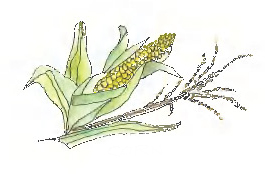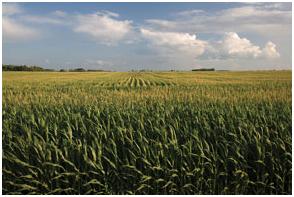
Corn queens, corn festivals, corn feeds, corn mazes, corn dogs, and corn monuments (a corn cob-topped water tower in Rochester, a 24’ corn sculpture in Olivia), –in many ways Minnesota pays homage to corn. And well it should. Corn is Minnesota’s most profitable crop and covers a lot of acres! In 2012, Minnesota farmers planted 8, 700,000 acres of corn on approximately 25,000 farms across the state. They had a bumper year, harvesting a record 1.39 billion bushels of corn and averaging about 165 bushels an acre. Using a price of $ 7per bushel, the total Minnesota corn crop in 2012 was worth approximately $1,155 per acre or $7 billion. Minnesota is one of the top four corn producers in the U.S., along with, Iowa, Illinois, and Nebraska.

Corn was not always the largest crop in Minnesota, but it is certainly one of the oldest. There are many records from the early European visitors that the Native Americans were growing corn. In August 1820 Gov. Lewis Cass and Henry Schoolcraft, a man studying Native American culture, witnessed a corn festival at Little Crow’s village near Fort Snelling on the Mississippi. This was called the “green corn dance.” Music, dance and feasting commemorated the importance of corn to the indigenous people’s way of life. A few years later, missionary Samuel Pond noted that “in 1835 the Indians at Lake Traverse seem to have raised a surplus of corn for Joseph R. Brown bought large quantities of it which he sold [to others] for a dollar a bushel.” Between 1830 and 1860 many advances in farm machinery were made, including the sheller, reaper, cast steel plow, picker, and planter. From the 1860s until the 1920s an open-pollinated technique was used, which yielded 25-30 bushels an acre. At the end of that era, the average price for corn was $.30 per bushel, and Minnesota had roughly 116 million acres planted, leading to an income of $34.8 million for the state.
Sweet corn canneries opened in Austin and Mankato in the 1880s, followed soon after by similar operations in Owatonna, LeSeur and Faribault. In 1903 the Big Stone Canning Company in Ortonville created an automated system of canning, with a conveyer belt, mechanical corn husking machine and a power-driven cutter. 1897 brought the MN #13 hybrid, developed at the University of Minnesota, which was better suited for cold climates and the short growing season. It soon became the most popular variety in the northern states.
The 1920s ushered in an era of research to develop hybrids that yield greater production. After WWII the use of fertilizers and pesticides became more common, leading to further increased yields. In the 1970s, production really took off as a result of the single-cross pollination, plus the readily available chemicals. Yields reached a new high of 70 bushels an acre.
In 1980, with the enactment of the first ethanol bill, corn farmers had even more demand for their product. The bill offered a four cent per gallon tax credit for fuel that was a 10% ethanol blend. In 1986, Minnesota produced one million gallons of ethanol. By 1994 that amount had increased to 24 million and in 2006, 850 million gallons.
Corn production today is very different from the early 1900s. The production is mechanized, with enormous tractors and implements to till and combines to harvest. New varieties of seeds that are resistant to certain chemicals, such as Roundup or Liberty allow the farmer to apply herbicides and not kill the corn. In addition, corn and corn products are being used to make items previously unimaginable. For example, corn is part of the fabric for clothes and the plywood for houses. But one thing has remained the same through the years—corn has had a significant impact on Minnesota, and will continue to play a large role in the economy for the future.
MINNESOTA 13
During Prohibition many Stearns County farms accrued great profit in distilling corn liquor moonshine. Dubbed “Minnesota 13,” the liquor became well known across America, said by many to taste very like “Canadian Club.” The moonshine was a premium quality twice-distilled and properly –aged whiskey. Minnesota 13 was the name of an open-pollinated corn, developed by the University of Minnesota and grown in Stearns County because of its shorter growing season. Many folks said that Holdingford was the “moonshine capital” of Minnesota.
Ultimately Federal agents were able to curtail these large operations by burning barns and sheds, by using informers to uncover facilities, and by increased surveillance. But for a decade, Minnesota 13 added to many farmers’ incomes.
Major Products
- Corn oil, which is extracted from corn germ
- Corn starch, derived from the endosperm. It has a wide range of industrial and food applications.
- Corn sweeteners, which supply more than 56% of the U.S. nutritive sweetener.
- Ethanol, refined from the starch of the corn kernel. Ethanol is an alcohol that has many industrial uses.
Did You Know?
- The scientific name for corn is Zea maize.
- Corn’s wild ancestor was Zea Mexicana, which originated in southeastern Mexico and Guatemala.
- Corn was domesticated 10,000 years ago.
- Christopher Columbus mentions corn in his journal, saying it was “well tasted.” Later he took corn back with him to Europe.
- The original “corn palace” was built in 1892 in Mitchell, South Dakota.
- The average ear of corn has 800 kernels, arranged in 16 rows.
- There are over 3,500 uses for corn.
- 75% of all grocery items contain corn in some form.
- Corn is grown on every continent of the world except Antarctica.
- Olivia, MN, in Renville County is known as the “Corn Capital of the World,” and Renville County produces the most corn of any Minnesota county.
- The value of the U. S. corn crop in 2012 was over $85 billion dollars.
For more information see the 10 Plants That Changed Minnesota MSHS book.